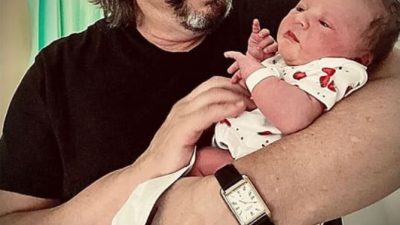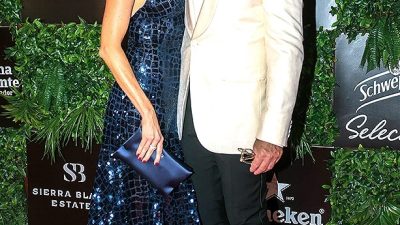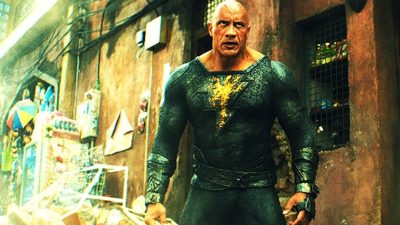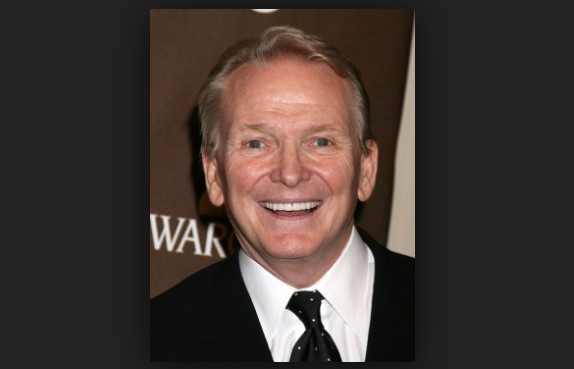Bob Mackie has got to be the busiest 80-year-old on the planet. In June, he’ll receive the CFDA’s Lifetime Achievement Award (his second from the organization; the first was a plaudit for his “fashion exuberance” in 2001) and possibly—probably—will win a Tony for his work on The Cher Show. May was no calmer, with new getups to make for Cher’s Here We Go Again tour, his inclusion in the “Camp” exhibition at the Met, and the announcement of a biographical documentary. And let’s not forget the release of Rocketman, with costumes inspired by those Mackie designed for Elton John back in the day. The list goes on . . . and it goes deep. Mackie’s been at this for 58 years.
Biographies will date the California-born costumer’s debut in the entertainment business to 1961, but Mackie’s fate was sealed much, much earlier—at the movies. He was entranced by the glamour of Carmen Miranda and the magic of the ballet in An American in Paris, and to this day he has retained a child’s sense of wonder, pairing it in his work with craftsmanship, humor, and an instinctive grasp of character. His interest lies less in what a character wears than in why.
Mackie has a golden roster of clients, but it’s his work for Carol Burnett and Cher that is best known. The curtain dress he concocted for Burnett’s “Went with the Wind” sketch is in the permanent collection of the Smithsonian. The bedazzling, befeathered, and body-revealing numbers Mackie’s made for Cher (and recreated for The Cher Show on Broadway) are inspiring new generations of starlets today. Here, 16 contributors, Burnett and Cher included, share their colorful memories of the iconic designer.
Bob Mackie was born in Monterey, California. After his parents divorced, the 6-year-old went to live with his grandmother. “It was kind of lonely, but I got used to entertaining myself,” the designer told Vogue in 1990, noting, “I was always pretty good with crayons.” Another diversion was the cinema, and it’s there that Mackie, “Mr. Hollywood,” fell in love with the movies.
BEGINNINGS
Bob Mackie: I was born in 1939, the grand year of the best movies ever made, you know Gone with the Wind, and The Women, and the incredible The Wizard of Oz; they’re all made in the year that I appeared.
NOT THE WHATS, BUT THE WHYS
Mackie: When I was a little kid, I mean really little, like 2 or 3, I would be taken to the movies by my mother and my older sister. They loved musicals and Technicolor and all that sort of thing, so I sat there and watched and watched and watched. And then all of a sudden I started paying attention to what was going on and started asking questions about the clothes: “Why did she wear that? Why has she got all the diamonds on—or whatever?” I just had all these [questions] I couldn’t figure out, because my family didn’t look like they looked in the movies. And my mother would explain and before I knew it, I was really interested.
LASTING IMPRESSIONS
Mackie: Of course, my favorite movie star at that point was Carmen Miranda because she was so much fun and she wore so many funny things, and so many colors, and high funny shoes, and fruit in her hat, and all this sort of thing. And then when I was about 10 or 11 years old, I went to see An American in Paris, and when the ballet came on, I just thought it was the most beautiful thing I’d ever seen. I thought, “Wow! This is beautiful. I bet I could do this.” Thank God when you’re young you’re kind of stupid and you just go forward and keep pushing. I stopped and looked to see if I could find out: Well, how did this happen? They had the costume designer’s name there. Irene Sharaff became my favorite, my idol. I wasn’t that interested in fashion, I really wanted to be part of the entertainment industry, and that’s kind of how it all started. I never kind of wondered what I would do, I just thought I’d do that.
EDITH HEAD
Mackie: I ended up working the minute I got out of school. I got a job in Hollywood at Paramount Studios working for Edith Head. It’s as simple as that. I much preferred working for Edith Head [than Jean Louis] because she gave me full rein. Edith Head had a lot of people that had been with her for a long time—two or three sketch artists—a lot of designers. They were sort of middle-aged ladies that loved to do little secretary suits and housewives, but when it came to doing anything slightly flamboyant, or if it was a musical, or a showgirl or something, they absolutely weren’t comfortable with it. Edith saw that in me, so every time there was something crazy it would come right straight to me to do. And it was fine with me; it was fun! She would say, “Draw some things up here.” So I sat down and I drew a bunch of stuff up, and she’d come back and she said, “Oh, this looks good. No, I don’t like this one.” Then she’d put pencils in her bun, like she’d just finished drawing them all, and went to see the producer. I thought, “Oh, okay. Well, that’s good. I’ll find out what works and what doesn’t.”
Flody Suarez, lead producer, The Cher Show: One of the things that I found so fascinating was that Bob was Edith Head’s assistant when he first started in the business. That, to me, just tells you so much, because she was the consummate movie costumer, and, for him to have learned his craft from her and then put his own signature on it, that’s pretty amazing.
RuPaul, actor, drag superstar: [When I think of Bob Mackie I think of] beading and proportions and colors and vibrancy and . . . cinematic. He is really the heir apparent of the glamorous Hollywood aesthetic, you know, the Busby Berkeley musicals and the great designers from films and theater.
JEAN LOUIS
Mackie: From Edith Head I went over to John Louis and worked on a Marilyn Monroe [Mackie drew the actress’s “Happy Birthday, Mr. President” dress], and I did their sketches for them. Jean Louis was Mr. Glamour. He loved fashion because that’s where he started, but when it came to designing anything for like a housewife he had no idea; he thought they all dressed like Donna Reed in the perfect shirtmaker dress and starched apron.
Ray Aghayan was Mackie’s partner in work and life. In 1974, Vogue introduced them to its readers thus: “Bob Mackie and Ray Aghayan came to show-wiz fame designing glitter costumes for onstage, on screen superstars Carol Channing, Diana Ross, Barbra Streisand, Carol Burnett, and of course, Cher. They also super-costumed Las Vegas’s Hallelujah Hollywood (over 700 costumes). The quintessential Bob and Ray: They reinvent period so fabulously that you believe the Bob and Ray way is how it really was. And they think—spectacular and funny.”
ENTER RAY AGHAYAN
Joe McFate, design director, Bob Mackie: Ray was Persian and he got himself into the United States, he learned to speak English, and he got himself an education, and directed plays and designed costumes. I believe Ray and Bob met at a Costume Designers Guild meeting out in Los Angeles. Bob was a sketch artist and Ray needed a sketch artist, so Bob drew for Ray, and then eventually I think Bob said, “Listen, I’m doing 50 percent of this work, I would like to share some credit with you.” And so they did.
Michael Berresse, actor (who plays the part of Bob Mackie in The Cher Show): In all honesty, I think seeing himself as a character in The Cher Show has been liberating for Bob, in a way. His freedom talking about his relationship with Ray Aghayan, for one thing—not that it ever was a secret—but I think that Bob is really proud of a beautiful life shared with someone.
George Schlatter, television producer and director: I had signed to do the Judy Garland series, and she told me that she had hired Edith Head to do her clothes. So I went to meet with Edith Head and it was explained to me that her plan would be to make five different outfits to camera test to decide which ones they wanted to use. I said, “No, I don’t think you understand, we will do five different gowns per show and there will be no testing.” And she said, “Well, that’s impossible.” And I said, “I think you’re right.” The next call I made was to Ray Agahayan who was working with a young man by the name of Bob Mackie, and I said, “I want you to design the clothes for the Judy Garland series.” And Bob was—he looks to be 9 years old now, but at this point he was actually 9 years old—and so I set up a meeting with Bob Mackie and Judy Garland and violins played, I mean you could see a love affair taking place.
Mackie: I was very unhappy in the beginning of my career because the clothes never came out right with the people that made them. Then I met this woman, Elizabeth Courtney, who had worked at Columbia Studios running the workroom. She was working for Ice Capades and that wasn’t her style at all; she was used to making clothes for Dietrich or Rita Hayworth (she did the famous Gilda dress). We had worked with Elizabeth on the Judy Garland show and she made the most beautiful clothes for Judy—and Judy didn’t have the easiest figure to deal with, [she was] 4 foot 11 inches and quite short-waisted; it just wasn’t an easy body to throw clothes on—and somehow we made her look absolutely fabulous. I said to my partner, Ray, we both are designers and we needed to do better product [and we asked her to join us].
THE CAROL BURNETT SHOW
Carol Burnett, actress: The show was going to go on in September of 1967 and my husband and I had seen a Mitzi Gaynor special . . . and I said, “Boy, the costumes she’s wearing are really great.” And then Alice in Wonderland was on television, and those costumes were just unbelievable, and we saw the credit—Bob Mackie—so we said, “Well, maybe we’ll be lucky enough to get him.” So we called, and we made an appointment for him to come over to the house. And bing-bong, there he was on time, and I opened the door, and he looked like he was 12 (he still does), and I said, “Are you Bob Mackie?!” (I think he was in his late 20s at the time), and he came in and we just said, “Okay, will you do the show?” and he said, “Yes,” and that was it.
Schlatter: When you realize how many costumes Bob did each week for The Carol Burnett Show, and the fact that each one of those costumes had to be built so the [actors] could get in and out of them in under a minute and still look stylish . . . he’s a genius, that’s all. Mackie is unique. He is a totally supportive force field of positive energy who is a delight.
Burnett: I don’t think there is anyone in the history of costume design who could do what Bob did, and continues to do. There are some wonderful costume designers on Broadway and in the movies—but Bob, on every one of my shows, did an average of 65 costumes a week. And he dressed everybody: the dancers, singers, the guest stars, us. He even designed the wigs and how the makeup might be. He designed all the funny stuff, and all the beautiful stuff. McFate: When Bob was doing The Carol Burnett Show and The Sonny & Cher Comedy Hour [etc.], he was offered a lot of other [jobs]. He was offered movies—he was offered The Great Gatsby. There were things he was offered that he turned down because he was loving what he was doing at CBS. That associated him with television. I’ve got to find the right way to say this, but a lot of people look down their noses at designers who make clothing for television.
Mackie: This last year it had been 50 years since The Carol Burnett Show came on the air. I loved working with Carol because she really let me contribute to the ideas, and sometimes I would help her with a character. You have to kind of work [character] out visually, and if it helps the comedy in her case, it’s even better.
Burnett: There were times when I didn’t know how I was going to do a character until I went to the costume fitting and put on what Bob had in mind. [I’d] look in the mirror and I said, “Oh! That’s who she is.” It was amazing. Tim Conway wrote those characters, and originally he had Mrs. Wiggins—she’s the secretary the IQ fairy never visited—being this kind of doddering old lady. I went into the costume and Bob said, “You know, we’ve been doing a lot of old ladies lately, let’s make her different.” So he turned her into this bimbo with the blond wig, and the push-up bra, and the real tight black skirt, and the high heels stilettos. And I remember, I put the skirt on—it was an old skirt he had in his costume place—and it was black wool and it was very tight at the knees, but it bagged in the behind. And I said, “Bob, you’re going to have to take it in back there, because I’m flat,” and he said, “No, no stick your behind into it.” And I did and that gave me that look, where it looked like she had a big rear end and that funny walk; that gave me her character.
And of course you know the Gone with the Wind [costume], that’s in the Smithsonian. Well, Bob came up with that, [too]. Originally it was written that I would come down the stairs with the draperies just kind of hanging on me—and you know Bob’s got this wicked, wonderful sense of humor—and he said, “You know, that’s not that funny.” So he sketched up [something new] and he called the prop department and said, “Send me over the curtain rod and material.” When I went into the fitting that Wednesday, he said, “I have an idea for the curtain dress.” I walked into the room and there it was, and I fell on the floor, I was laughing so hard, and I said, “This is going to go down in history as one of the greatest sight gags ever in the history of television”—and it has.
Fern Mallis, industry consultant: The curtain dress is the first thing that comes to mind always, [when you think of Bob]. It’s an extraordinary piece of fashion history.
Gregg Barnes, costume designer: The curtain dress is so, so iconic, I think they should put it in a box of all the most famous things from the 20th century.
THE SONNY & CHER COMEDY HOUR
Mallis: You can’t think of Cher without thinking of Bob Mackie, and there are not all that many people that you can make those relationships with that count.
Suarez: Bob was kind of a household name during The Sonny & Cher Comedy Hour, and I’m not even sure how that happened because I don’t think any TV designer has ever crossed over in that way to become part of pop culture the way he [did]. Bob and Cher [were] creating an image for him as much as they were for her.
Mackie: I was doing quite a lot of variety television because it was the nearest thing to movie musicals at the time. Sonny and Cher’s pop music thing was big for a moment and then it went away; it was like a novelty. After a couple of years working in Vegas, doing stand-up, and singing, and making jokes and whatever, CBS hired them to do a weekly show. I’d seen all these pictures of Sonny and Cher, “The world’s first hippies.” They were kind of like New Age cave people; there they were in their fur vests and funny pants and belts and just a whole look that nobody had had up until that time. We didn’t know what hippies were quite yet. When I met Cher, I don’t know, I just thought she was the cutest thing ever, and then I looked at her figure and I mean I thought, Oh, my goodness, she’s like a model; she’s so beautiful and so unusual. And so that’s kind of how it started. The producers didn’t know what to do with Cher, and I said, “She could be anything! She doesn’t look like all the blonde girls with the beehive hairdos and the flips that are out here now. She’s a whole different kind of a girl, and she could be anything.” She started appearing and wearing, kind of you know, slinky clothes, because her body was perfect and she could wear anything—you could expose practically anything; it was amazing—so we just started doing crazy stuff on her. When I first started doing Cher, these starlets were coming out of the woodwork. They’d want me to do a dress—“something like Cher’s”—and I’d just say, “You’re not Cher.” As a designer I tried to be part of the production, come up with ideas, and it worked, I must say; she’s still doing it—she’s still wearing her warrior goddess outfits right and left.
Cher: I met Bob when I was 19. It was truly love at first sight. Sometimes we don’t even have to talk, we just know. We’re like two mischievous kids getting into trouble.
SEVENTH AVENUE
McFate: I’m not sure exactly who talked Bob into doing Seventh Avenue. I suspect it was Ray Aghayan. Well, because Bob was associated with television—and the red carpet, of course—the fashion industry looked at him as a Hollywood guy. They called him “Off-Barnum Bob,” the “Sequined Sheikh,” and the “Rajah of Rhinestones.” I think he could never really get a footing in the fashion world.
Mallis: I’m not exactly sure why, but it was clear that Seventh Avenue didn’t really embrace him and never made it easy for him. I think his clothing was perfectly fine, but it just never captured the imagination. Maybe people felt if they were going to wear Bob Mackie, they wanted something sexy and fabulous, not day clothes. Maybe his name was too associated with a complete other classification.
Jan Strimple, Mackie muse, model turned show producer: I recall the headlines in Women’s Wear were something like, “Hollywood Boy comes to Seventh Avenue.” You know, snoot, snoot. I look at it this way: Bob had succeeded before he came to Seventh Avenue. He was just playing in a new sandbox. Can Seventh Avenue . . . make or break you financially? Sure it can, but was it going to make him a success in the eyes of the American public? Bob was a star by name in the ’80s. He was really a pioneer of branding an American designer. Bob had the pulse of his clients; he listened to them and he knew what they wanted and he gave the stores what they didn’t have. Isn’t it Diana Vreeland who said that?— “Give them what they don’t know they want?” Well [that’s what he did].
RED CARPET FOLLIES
Tom Ford, designer, film producer and director, CFDA Chairman: Bob Mackie’s work has influenced fashion in a dramatic way, in that many of the body-fitting, seemingly transparent, and heavily beaded gowns that are worn on red carpets today are derivative of his work for stars like Diana Ross and Cher. The images of his costumes and gowns for these women have become a part of the landscape of fashion from the ’60s, ’70s, and ’80s, and in my case, become part of my hard drive of references. His famous quote that his clothes are “for the woman who is not afraid to be noticed” is one of my mantras. Mallis: Bob does glamorous clothing. He really was the first to do those sexy red carpet dresses, and everybody who is designing clothes for the red carpet really owes him a debt of gratitude. He’s the first one who worked all that Hollywood kind of showgirl [flair] and took it out of the burlesque house, out of Vegas, and put it on the red carpet [in a way that] was sexy and flattering.
Mackie: They [have been some] indelible moments of [red carpet] craziness, really. For the Oscars in 1986, Cher herself said: “I don’t want to wear just an evening gown. I want to wear an outfit. I want to wear something really fun.” I had done several outfits for her over the years, some of them were bare midriff and whatever. She said, “No one’s seen me dressed up for a couple of years,”—because she had stopped and done a play and some movies—and I said, “Okay, what would you like?” “Well, I want a big headdress.” “A headdress? You know you’re on the Academy Awards.” “Oh, well, the people would like to see me that way.”
Mallis: When Cher told Bob what she was wanting to wear and how extravagant she wanted it all, he kind of resisted and said, “But you’re presenting an award, you’re going to take the attention away.” As it turns out, Don Ameche said he never got more photographed and more publicity than he did when Cher wore that dress to present to him—which was kind of her way of saying “Fuck you” to the Academy because she wasn’t nominated for Mask.
Mackie: The picture of Cher giving the award to Don Ameche was in every newspaper across the country—across the world—and they keep printing it every year. And then all these people, the Kim Kardashians of the world, start copying her. I mean line for line, bead for bead. I look at it and I say, “I didn’t make that. Where did she get that?” So people are really still fascinated with Cher.
Suarez: They both inspired each other and pushed each other. I think there were times where Bob would have liked Cher to be a little more demure, and she would just look at him and go, “Nope, we’re going big here. Let’s shock people.” And there are times where I think she wanted to be more demure and Bob would convince her to be a little riskier, to take a little bit bigger of a swing at something.
CRAFTSMANSHIP
Mackie: You can’t make these crazy-ass clothes unless they’re beautifully made, and hopefully perfectly proportioned for the woman. I grew up around people that made clothes for film in the old days when everything was made from scratch, even the little black dresses for the secretaries behind their desks. You can make the best designs in the world on a piece of paper, but if they aren’t made beautifully and they don’t fit right, it just doesn’t work—especially when clothes as clothes are as goofy as some of the ones I’ve done like for Cher. They have to sit perfectly. They can’t start moving around in the wrong places, you know what I mean?
Cher: Bob and I are both perfectionists when it comes to fit. We’re never satisfied until every inch is perfect.
Dorothy Crutcher, patternmaker: Certainly Bob has very high standards for how the finished product needs to look. [On one project] we were getting down to the wire and I was getting really worried about finishing it, and I remember him saying to me, “There’s always time to make it perfect.” At the time it didn’t really help, [but] I do think of that and I think, “Yeah, you know what? You’re right. What’s the point in doing it if you’re not going to make it perfect?”
Bette Midler, actress: I do have to say spending time in his workshop was one of the greatest experiences of my life. It was full of artists and artisans at the top of their game. He is also one of the dearest people on the planet. I loved every minute working with him; the work was brilliant, and the workmanship impeccable.
RuPaul: I can’t say enough good things about Bob Mackie. Not only is he just a lovely and pleasant person to work with, but the talent is beyond. It’s too bad that people have sort of put him in the costume realm because it really is high art, actually.
Crutcher: Bob sees how you can put things together in a way that I think that a lot of other people don’t see. Nobody else does it quite like him, where he’ll layer things and then add to them and then manipulate them in certain ways. The workmanship becomes a really integral part [of the design]. [Many designers are] not very interested in the construction of the garment. Bob [is]. He thinks about how things are going to be made as he’s sketching, so the function of it becomes part of the form. What that means is when he shows me a sketch, he’s already got ideas of how the piece is actually going to be constructed in three dimensions; he really understands and is interested in how [a piece] is going to go together, and he sees how that plays into making it look the way he wants it to look. [I think] he sees the actual construction of [a garment] as part of the aesthetic.
McFate: I thought I was meticulous— you have no idea how important the fitting process is to him. Once we solve the problems in the fitting, then [there is] nothing to worry about on the runway or onstage.
Strimple: Juliet Prowse was a premier dancer who Bob asked to [model]. She and I were having a conversation backstage and Juliet said what she loved about Bob’s clothes were [their inner structure]. Her words were something to this effect, “I can stand in a Mackie and kick my leg up over my head and bring it back down and the bodice never moves.” Bob understands movement and how a garment needs to sit on a woman’s body. His pieces sit on the body like couture [does].
Burnett: They call Bob the sequin king and all of that; well, just take a gander at some of our shows and you’ll see not only just beautiful costumes—and they’re beautifully made—but that he knows how to dress a woman to her advantage.
McFate: Everyone thinks, Oh, you just dash things off for the stage, but we like things beautifully made. One of our rules and tenets of doing things, especially for people like Cher, is it can be camp, and it can be large flowers and wonderful things, but it Must. Be. Beautifully. Made. It’s no good if it’s casually made. All the things we’ve made for Cher over the years are all hand-embroidered, beaded, whatever. Wonderful pieces that look gorgeous in the hand as well as on the body.
ON CAMP
Mackie: The CFDA gave me an award quite a few years ago, actually. They wanted to give me something but they didn’t know what to do with me, so they gave me an award for fashion exuberance, which I still think is funny.
Strimple: You know one of my most joyous moments was when the CFDA wanted to give Bob an award and he didn’t fit in any category that they had, so they created an award for him, it’s called the exuberance award, and it sums up everything Mackie, because he’s an original. You can’t ignore his presence and his success even if he’s not your cup of tea.
Bernadette Peters, actress: The Met “Camp” show is right up his alley.
Mackie: The whole camp thing . . . I haven’t even heard that word in 40 years. Everybody has a different idea [of] what constitutes camp. It can be what you say, or what you wear, or how you wear it. Movies are a treasure trove of camp. I think some of the early 1930s films are the campiest things that ever happened, and they still are. There were characters (usually on the gay side), and they had the best, the funniest lines. It was all camping and it was all tongue-in-cheek. Nobody ever said in a script, “That man’s gay; he’s acting so silly.” He was just this character in the play whether he was the concierge, or the funny uncle, or the man that designed costumes in a show.
Suarez: If you go back to The Sonny & Cher Comedy Hour and The Cher Show [on television], a lot of what they did in those sketches was campy and was played for the laugh, and the costumes fed into that. Bob also did that with The Carol Burnett Show. Somehow the way he looks at costuming enhances the joke of a comedy scene. There’s a great line in the [Broadway] show where a censor complained that there was underboob showing. Bob’s response was, “Well, if we stand her on her head, it will just be cleavage.” It’s something he actually said, and we put it in the show and it gets a roar every night. I think that’s how Bob looks at things, that if you just stand something on its head, it’s not so shocking anymore. So the two of them [Bob and Cher] would go out and look at things from every angle and create looks that people would just be wowed by. I don’t think camp is a bad term, I think camp is another way of saying they shocked people, and sometimes it made them laugh and sometimes it just left them in awe.
MACKIE’S LEGACY
Mackie: I think I have a broad range, but if you’re doing a certain kind of work all the time, people put you in that niche. For a long time, and I’m sure [it’s still true today]—everyone thought that all I know how to do are Cher dresses—you know, with her tummy out and showing half of her whatever. By the way, that’s a character she plays. I always just sort of pray in my life somebody will give me a nice 19th-century movie or a good 1930s Depression film [to do].
Ford: Bob Mackie is one of the most influential and inspiring of all American designers. As a costume designer, he influenced fashion dramatically. Costume designers have long been overlooked for the importance of their work in creating and influencing mainstream contemporary fashion.
RuPaul: When I got famous, the first phone call I made was to Bob Mackie, because I grew up watching The Carol Burnett Show and The Sonny and Cher show and I knew that the mark of a superstar was to have Bob Mackie costumes. So he designed the costumes for my first Las Vegas [revue]. In fact, on the TV show that I just finished filming for Netflix, called AJ and the Queen, one episode is a Bob Mackie episode. This kid and I who are traveling cross-country, we stop at the fictional Bob Mackie Museum in Mt. Juliet, Tennessee, and in that episode I get to pull out some of my old Bob Mackie costumes and wear them.
Peters: He’s glamorous, maybe that kind of glamour [comes] with taking risks—he took a lot of risks. You always associate his name with glamour, although his sense of humor and, of course, the comedy are beyond. It’s just wonderful that he’s being recognized right now for the great talent he is and the inspiration, actually, that he’s given young people. There are a lot of young designers coming up that have been inspired by him and appreciate him.
Alessandro Michele, Gucci Creative Director: I knew everything Bob Mackie did, because when I was young I knew everything about rock stars. I knew everything—[except] that he made those dresses. As a grownup, I discovered that the genius behind those gorgeous outfits was Bob Mackie. His work was not [about] business; it was the emphatic work of an artist for other artists. It was incredible how he was able to give life and a look to notes and lyrics. Bob Mackie was the engine of an incredible moment: most probably Cher would have not been Cher without his designs.
I was thrilled when I had the chance to see the clothes he did for Elton [John, which were referenced in Michele’s Spring 2018 Gucci collection.] When you touch his creations, you have the feeling of being in contact with an artefact. [Bob has] contributed to the industry the idea that clothes have a soul [rather than being] simply pieces of fabric.You have to put energy inside clothes; Bob’s creations made impetuous energy of great artists and through his clothes the artists were able to magnify their talent. Bob Mackie sanctified the voice and the attitudes of the rock stars who are the gods of the 20th century.
I am incredibly happy to have had the chance to meet him at the Met. He is good looking, elegant and has a charming voice. For me it is like having met a guru.
Berresse: Bob truly does believe that you have to have fun in this life. He has certainly dealt with his share of heartbreak and tragedy (and that’s something I think he shares with Cher; they bonded on that as well), but he chooses joy, he chooses life, he chooses color. And it’s not just about sequins and the bugle beads for the sake of the sequins and bugle beads; it’s that they create this sort of shimmering moving work of art that really literally and figuratively reflects light. I think he loves how his work and his creativity has given the world a little bit of joy, a little more color.
Midler: He’s a genius, and genius goes in and out of fashion. Some may say [his work is] objectifying women, but when you have women like Cher, Tina [Turner], and Carol [Burnett], their talents are so gigantic that they deserve to be objectified! He has made thousands of brilliant costumes in his day and should have a show of his own at The Met. People would die.
Shalom Harlow, model: You can’t be a shy wallflower in a Mackie; you’ve got to be ready to stand out. Mackie doesn’t scare me—you know I can handle a little bit of extra fabric. His is a singular vision without compromise, and his creations are almost operatic. I chose [to wear Mackie [to the 2009 Met Gala] because to me it represented all the glory and pomp of a red carpet fashion moment at its best. (Later, I donated the dress, and it was auctioned to help buy solar panels for a hospital in Burundi, which is now entirely energy independent.)
THE MAN
Mackie: You have to do something that you love. I have this horrible kind of fear of retiring and not doing anything because I would be so unhappy, and, when you’re like that, I think you die early—you just have no hope about anything. I was just lucky; I mean I really never changed in what I really wanted to do and where I wanted to work.
McFate: I can honestly say that he appreciates it when people appreciate what he does, but it has always been about the work. It was always work that saved him. When his son, Robin, was very ill and passed, thank God, he had a project to help him through that time, to distract him from the great grief. Time and time again he returned to work; it was his salve. His comfort was work, and it still is.
Berresse: [What was] most important to me was to make sure that Bob’s joy, his humor, his childishness, childlikeness, came off onstage. I think that’s a hallmark of most of the things that Bob has made in his life; he still looks at fashion or costume, or culture really, through a child’s wondrous eyes. He finds so much joy; he literally loves working and he loves the process of working.
Strimple: [Once after a dinner at his home,] Bob brought out glass ice buckets and in them were all kinds of Push Pops and Dreamsicles and drumsticks—all the frozen things of our youth—and everyone turned into a child. That’s Bob: a beautiful meal and then . . . boom! We’re going to laugh together.
Crutcher: I think if you had asked me what kind of a person Bob Mackie would be before I met him, I would never have really guessed that he would be as funny as he is, and just as—down-to-earth is such an overused expression but I guess he kind of is. He seems more like a friend. He’s obviously a brilliant designer, but he’s not full of himself and overly dramatic in his regular day-to-day life.
McFate: He does these outrageous big things that get a big reaction, but as a man he’s quite modest. It’s like a dichotomy. You’d think he’d be on a grand scale of a European designer—“Oh, darling, I can only come here and I can only do this”—he’s not that way at all. He’s very down-to-earth.
Barnes: Back in the late ’70s, I was an aspiring costume designer, and Bob Mackie was who we all aspired to be, or know, or have some connection to his magic. A friend of mine arranged an interview for me with Bob. He was such a busy guy, but he gave me well over an hour of his time, and treated me like a colleague. Later, [when I was] nominated for a Tony for the very first time, in the mail I get a letter from him. I hadn’t seen Bob in about 15 years. [It was] just the kind of thing you think never happens; when someone sees you and recognizes you for your own [worth].
Strimple: Well you know, he’s the perennial boy. He’ll be a boy until we’re reading his obituary, I mean he will be.
Original article: https://www.vogue.com/projects/13550961/bob-mackie-oral-history-cfda-lifetime-achievement-award-2019-carol-burnett-cher-tom-ford-rupaul/

























Comments